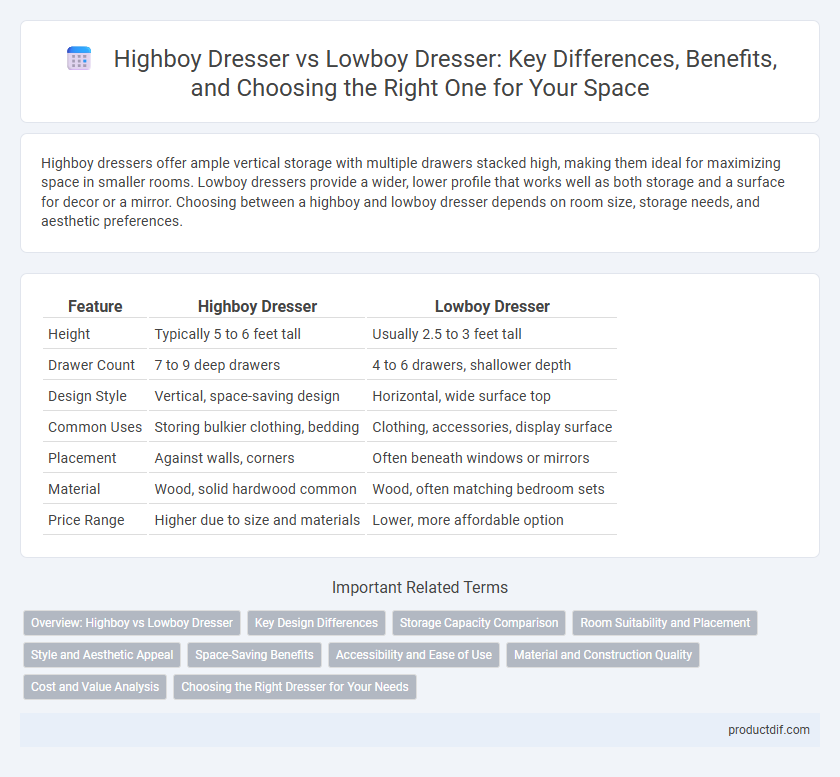Highboy dressers offer ample vertical storage with multiple drawers stacked high, making them ideal for maximizing space in smaller rooms. Lowboy dressers provide a wider, lower profile that works well as both storage and a surface for decor or a mirror. Choosing between a highboy and lowboy dresser depends on room size, storage needs, and aesthetic preferences.
Table of Comparison
| Feature | Highboy Dresser | Lowboy Dresser |
|---|---|---|
| Height | Typically 5 to 6 feet tall | Usually 2.5 to 3 feet tall |
| Drawer Count | 7 to 9 deep drawers | 4 to 6 drawers, shallower depth |
| Design Style | Vertical, space-saving design | Horizontal, wide surface top |
| Common Uses | Storing bulkier clothing, bedding | Clothing, accessories, display surface |
| Placement | Against walls, corners | Often beneath windows or mirrors |
| Material | Wood, solid hardwood common | Wood, often matching bedroom sets |
| Price Range | Higher due to size and materials | Lower, more affordable option |
Overview: Highboy vs Lowboy Dresser
Highboy dressers are tall, multi-drawer chests typically reaching six feet or more in height, offering significant vertical storage space ideal for bedrooms with limited floor area. Lowboy dressers are shorter and wider, usually around waist height, providing an expansive surface for decorative items while maintaining accessible drawer storage. Choosing between highboy and lowboy dressers depends on room size, storage needs, and aesthetic preferences, with both styles available in various wood finishes and traditional or modern designs.
Key Design Differences
Highboy dressers feature a tall, vertical structure with multiple stacked drawers, typically measuring around 6 feet in height, maximizing vertical storage in compact spaces. Lowboy dressers are shorter and wider, often used as vanity tables or bedside storage, emphasizing horizontal space with fewer, larger drawers. The key design differences revolve around height, drawer arrangement, and functional use, catering to varying storage needs and room layouts.
Storage Capacity Comparison
Highboy dressers offer significantly more storage capacity with multiple stacked drawers, typically four to six tiers, ideal for organizing bulkier clothing and accessories. Lowboy dressers provide fewer drawers, usually two to three tiers, emphasizing surface space over vertical storage. Choosing between them depends on the need for maximizing drawer volume versus accessible tabletop area.
Room Suitability and Placement
Highboy dressers, typically taller with multiple drawers, suit bedrooms with ample vertical space, maximizing storage without occupying much floor area. Lowboy dressers, shorter and wider, fit well in rooms with limited height or under windows, offering convenient access and a surface for decorative items. Choosing between highboy and lowboy dressers depends on ceiling height, room layout, and desired storage capacity to enhance both functionality and aesthetics.
Style and Aesthetic Appeal
Highboy dressers feature a tall, vertical design often adorned with intricate moldings and ornate hardware, making them ideal for traditional or classic interior styles. Lowboy dressers, with their shorter, wider proportions and minimalist lines, complement modern, contemporary, or mid-century aesthetics. Both types offer distinctive visual appeal, with highboys emphasizing elegance and grandeur, while lowboys contribute to a clean, streamlined look.
Space-Saving Benefits
Highboy dressers maximize vertical storage with multiple tall drawers, ideal for small rooms needing efficient use of wall space. Lowboy dressers offer a wider surface area with fewer, longer drawers, providing both storage and space for decorative items without overwhelming a room's height. Choosing between the two depends on whether prioritizing vertical space conservation or horizontal surface utility better suits the furniture layout.
Accessibility and Ease of Use
Highboy dressers provide elevated storage with multiple tall drawers, making it easier to access items without bending, ideal for individuals with limited mobility. Lowboy dressers offer a wider, shorter design that allows for easier reach into drawers but may require more bending to access lower storage. The choice between highboy and lowboy dressers depends on user preference for drawer height and accessibility needs in daily use.
Material and Construction Quality
Highboy dressers are typically constructed from solid hardwoods like oak, cherry, or maple, offering superior durability and a classic, robust design with intricate craftsmanship. Lowboy dressers often use a combination of hardwood frames with plywood or veneer panels to balance sturdiness and cost-effectiveness, resulting in a lighter but still durable piece. The joinery techniques in highboys usually involve dovetail joints and reinforced corners, whereas lowboys may incorporate simpler butt joints and glued components, impacting overall longevity and structural integrity.
Cost and Value Analysis
Highboy dressers typically command higher prices due to their taller structure and increased storage capacity, offering more vertical drawer space ideal for bedrooms with limited floor area. Lowboy dressers, often preferred for their lower profile and ease of access, tend to be more budget-friendly while providing sufficient storage for minimalistic or compact living spaces. Evaluating cost against value, highboys deliver enhanced organization potential, whereas lowboys offer practicality and affordability, making the choice dependent on specific storage needs and room dimensions.
Choosing the Right Dresser for Your Needs
Highboy dressers typically feature multiple stacked drawers and stand around 5 to 6 feet tall, making them ideal for maximizing vertical storage space in smaller rooms. Lowboy dressers, usually about 3 feet high with a wider surface, offer more accessible drawer organization and can double as display or workspace surfaces. Selecting the right dresser depends on your storage needs, available space, and aesthetic preferences, with highboys suited for compact areas and lowboys preferred for ease of access and multifunctional use.
Highboy Dresser vs Lowboy Dresser Infographic

 productdif.com
productdif.com